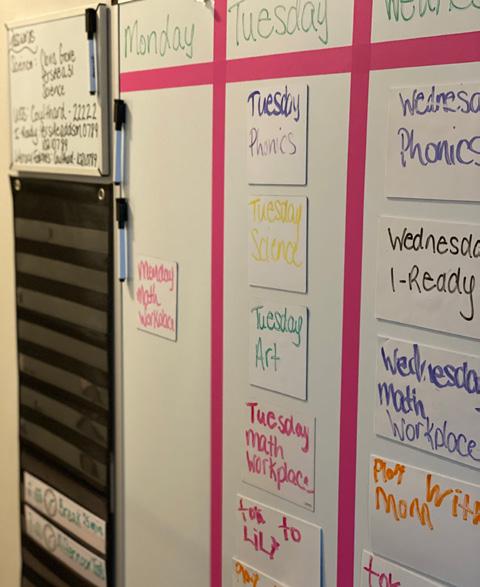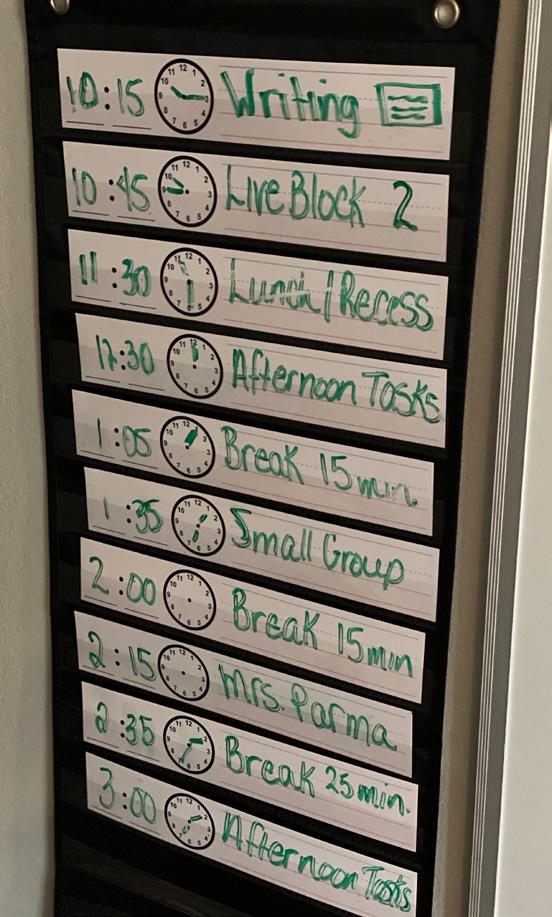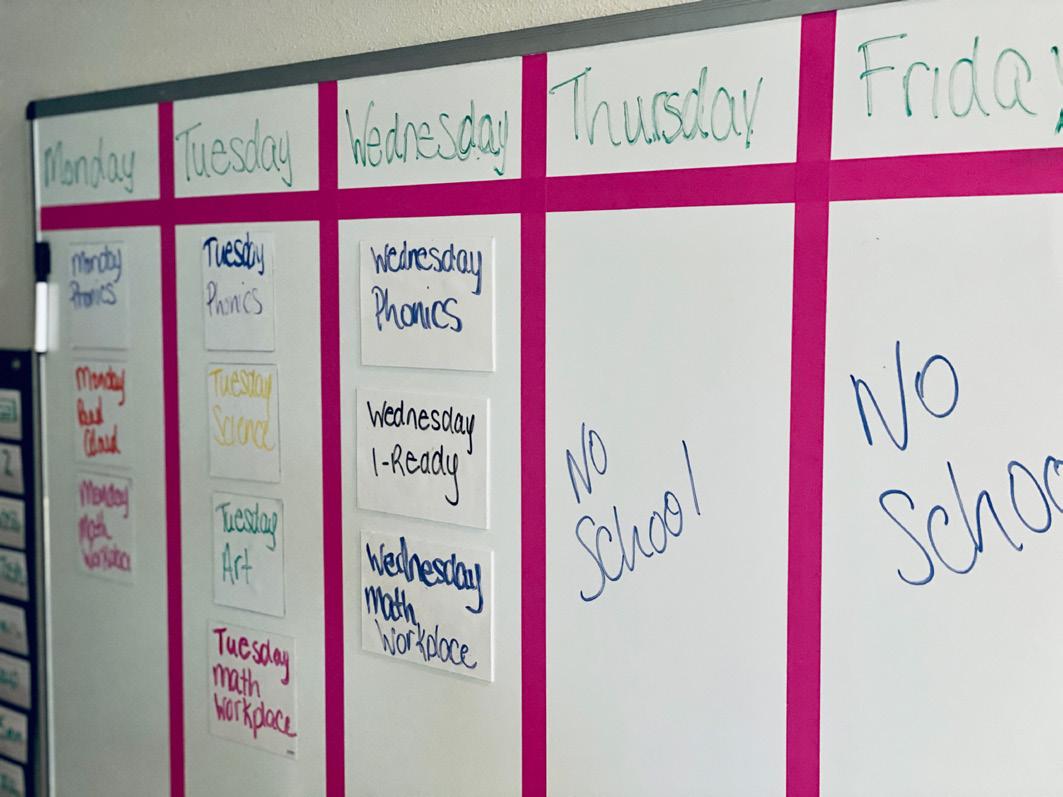
7 minute read
EXECUTIVE FUNCTIONING SUPPORTS FOR VIRTUAL LEARNING
Executive Functioning Supports for Virtual LearningBy Connie Persike, MS, CCC/SLP
WHETHER YOU ARE WORKING FROM HOME, A STAY-AT-HOME CAREGIVER, OR COMING HOME IN THE EVENING TO HELP YOUR CHILD WITH VIRTUAL SCHOOLING, EXECUTIVE FUNCTIONING SUPPORTS CAN HELP. I’M NOT SURE ABOUT YOU, BUT I FOUND MYSELF ARGUING WITH MY DAUGHTER MUCH MORE OFTEN THAN IS TYPICAL AT THE BEGINNING OF THE YEAR.
None of the familiar routines to transition back to school had occurred. We didn’t go school supply or clothes shopping. Her school canceled picture day in August as well as their Open House. All these rituals help all of us transition back to school after the summer break.
Due to the high amount of COVID-19 cases in our area, we had none of our typical routines and rituals to foreshadow the beginning of the school year. For my daughter, that meant she was still in summer mode. She wanted to play! She was also at home trying to focus and work with all her toys around her, pulling her away from an academic mindset and focus.
Those first weeks were a challenge, to say the least! I was trying to work virtually with continued distractions; we had too many passwords to remember and so many new virtual platforms to learn. I found myself in power struggles with my daughter to get her work done, but I didn’t have the time to follow through and ensure her tasks were completed. This led to evenings in front of the computer screen yet again to get her asynchronous learning completed. We were all doing the best we could, but something had to change.
Enter executive functioning supports! These have been my lifesaver during this time. Executive functioning supports are strategies that help us plan our day, organize our time, accomplish our goals, and regulate our emotions. Think of executive functioning skills as the skills managers need to manage a company. During times of stress, executive functioning skills are one of the first skills to weaken. Our pre-frontal cortex goes “offline” during chronic stress and fatigue. We need to rely on external supports. This article will provide you with some strategies that can help you get organized, remain focused, and accomplish the tasks that need to get done, all while hopefully decreasing power struggles with your child and helping them stay focused and regulated.
Visual cues for when to interrupt a caregiver
One of the first supports we needed to get in place were visual cues for when my daughter could enter my office and her dad’s workspace while working from home. I was supervising graduate students at the university, delivering professional development, and providing teletherapy to students. My husband was teaching from home. We implemented a color-coded system to cue our daughter when she could interrupt us during our work times because we, like many others, were trying to do this all without childcare or extra support. The color-coded system consisted of the following expectations:
Green: Enter as needed
Yellow: Knock and quietly enter the room
Red: Only enter in an emergency
You can use low-tech visual supports such as stop, do not enter, and yield signs or high-tech battery-operated lights that can be placed outside workspaces.
Timers can help you and your child plan
I found my daughter consistently asking her teacher or me how long her synchronous or live meetings would last. Timers were a great solution. It is important children know what they have to do, how long they have to do it, and when they are finished. Timers also helped remind us of when live meetings were scheduled because, let’s face it, when we are in the zone at work, time can slip by quickly. The following timers may be helpful:
y Clock timers
y Oven timers
y Amazon Alex or Echo
y Google Home
y Digital timers
y iPad timer apps

Password organization is key
This may seem obvious, but when we are in survival mode, it does not always happen. Carve out some time and get those passwords written down in a central location. We chose a small 10x13 dry erase board to write out all passwords and posted it right above my daughter’s daily schedule.
Daily schedules and to-do lists make a difference
Get those schedules written down! Most classrooms have daily schedules displayed somewhere. Even if you have a schedule in your child’s virtual classroom, it’s not the same as seeing it laid out clearly on one page in a place you can access at any time. This has been such a great help for us!
Making the schedule interactive is extremely helpful for task completion. It brings the child or adolescent back to the schedule and gives a sense of accomplishment when an item is removed or crossed off. Different methods to indicate completion can consist of crossing activities off when they are finished, removing tasks from the schedule, placing an X over activities, or moving them to another column. A daily schedule should be organized in a top-down or left-to-right fashion and consist of one column or one row only. Resist the urge to add another row or column. Multiple rows and columns become visually overwhelming as well as difficult for children to understand as they often look and read like a choice board rather than a schedule. This is especially important for individuals who use a communication device or visual choice boards to communicate their wants and needs.
I decided early on I was not going to fight all day with my child. It was affecting our relationship, making our days difficult, and putting too much pressure on all of us. This is when I remembered a strategy useful for individuals who procrastinate—make the to-do list moveable so that if tasks do not get finished, they have to be physically moved to the next day. This allows the individual to see and visualize the tasks or todo items pile up. We decided to use a large magnetic dryerase board divided off with tape by days as well as magnetic dry-erase Post-its. It is also possible to do this with a weekly paper calendar and Post-it notes; either will work.
Write each task on a Post-it note for each day. Color-coding by days or subjects can be helpful as well. When tasks are completed, remove them from the list. If tasks are not complet-




ed, physically remove the Post-it and place it on the next day. Continue doing this until the to-do item is completed and can be removed. Our first week of implementation led to a very long Saturday and Sunday catching up on tasks!
During times of stress, we must rely on external supports. Our neurology requires it. These strategies and supports can help you manage your household by supporting your executive functioning skills. Remember to be kind to yourself. We are all doing the best we can in this new reality. I’m truly hopeful one, some, or all of these strategies will help you during this uncharted territory we are experiencing, trying to juggle careers, parenting, and educating our children. Be safe, and stay well.
Connie Persike, MS, CCC/SLP, is a highly experienced speech-language pathologist with 20 years’ experience in private practice and school settings. She is the founder of CP Consulting, where she brings her experience to provide insight, guidance, coaching, and support to school districts, agencies, and families across Wisconsin needing expert direction in working with children. In addition to running her business, Connie teaches part-time at the University of Wisconsin Madison as a Clinical Associate Professor in the Communication Sciences & Disorders Department. Connie has been invited to present at a state level on a variety of topics such as functional behavioral assessments, positive behavioral supports and interventions, autism, anxiety, and evidence-based interventions. She is a member of the American Speech Hearing Association, the Association of Supervision and Curriculum Development, and the Autism Society of Wisconsin. Connie has been involved in statewide work groups to help develop and improve core programming in schools and is a published writer for Autism Parenting Magazine. Connie resides in Waunakee, WI, with her husband and daughter. During her free time, she enjoys spending time with her family, reading, and landscaping.
REACH YOUR CUSTOMERS IN THE NEW YEAR
ADVERTISE WITH US

EXCEPTIONAL NEEDS TODAY










